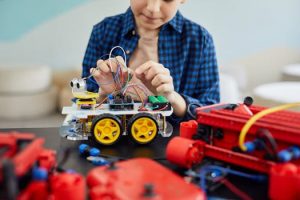Multi-Modal Learning: Engaging All Learning Styles
In today’s increasingly diverse and fast-paced world, it’s more important than ever for educators to recognize and accommodate the varying learning styles of their students. Traditional teaching methods, which primarily rely on lectures and textbooks, often fail to engage certain types of learners. This is where multi-modal learning comes in. By incorporating multiple modes of learning, such as visual, auditory, and kinesthetic, educators can create a more inclusive and effective learning environment for all students. In this article, we’ll explore the concept of multi-modal learning and how it can engage all learning styles.
What is Multi-Modal Learning?
Multi-modal learning is an approach to teaching that incorporates different modes of learning, such as visual, auditory, and kinesthetic, to cater to the diverse learning styles of students. Each individual has their own unique way of processing and retaining information, and educators must take this into consideration when designing their lessons. By utilizing multiple modes of learning, educators can create a more comprehensive and engaging learning experience for their students.
The Three Learning Styles
Before delving deeper into multi-modal learning, it’s important to understand the three primary learning styles: visual, auditory, and kinesthetic. Visual learners prefer to learn through images and visual aids, such as graphs, diagrams, and charts. Auditory learners, on the other hand, learn best through listening and speaking, and often benefit from lectures, discussions, and audio recordings. Finally, kinesthetic learners are hands-on learners who learn best through physical activities and real-life experiences.
It’s worth noting that while individuals may have a dominant learning style, most people are actually a mixture of all three. This is why multi-modal learning is so effective, as it ensures that all types of learners are engaged and have the opportunity to excel.
Engaging Visual Learners
For visual learners, incorporating images and visual aids into the learning process is key. Educators can use PowerPoint presentations, videos, and infographics to supplement their lessons. By doing so, visual learners can better understand and retain information, as they can see it visually presented in front of them.
Engaging Auditory Learners
For auditory learners, incorporating discussions and group activities into the learning process is beneficial. Reading aloud, recording lectures, and hosting group discussions are great ways to engage auditory learners. These activities not only allow them to hear the information, but also give them an opportunity to discuss and process it verbally.
Engaging Kinesthetic Learners
Kinesthetic learners thrive when they are able to physically interact with the material. Hands-on activities, such as experiments, simulations, and role-playing, are great ways to engage kinesthetic learners. These activities not only keep them actively involved in the learning process, but also allow them to connect the information to real-life experiences.
The Benefits of Multi-Modal Learning
Multi-modal learning has numerous benefits, both for students and educators. For students, it ensures that all learning styles are catered to, which leads to a more inclusive and engaging learning experience. This can also improve retention and understanding of the material, as students are able to process it in their preferred learning style. Additionally, by incorporating a variety of activities and modes of learning, students are less likely to become bored or disengaged.
For educators, multi-modal learning allows for a more versatile teaching approach. They are able to use a variety of methods and materials, which keeps the class dynamic and interesting. Multi-modal learning can also highlight any potential learning disabilities or difficulties that students may have, as they may excel in one mode of learning and struggle in others.
Incorporating Multi-Modal Learning in the Classroom
One of the key aspects of multi-modal learning is flexibility. Educators should strive to incorporate various modes of learning into their lessons, and be open to adapting their teaching methods to cater to their students’ needs. Regularly assessing and understanding the learning styles of students can also help in designing more effective lesson plans.
Moreover, educators should encourage collaboration among students of different learning styles. This allows for peer-to-peer learning and helps students learn from each other, regardless of their preferred learning style. By creating a positive and inclusive learning environment, students are more likely to engage and excel in their studies.
Conclusion
Incorporating multi-modal learning in the classroom is crucial for engaging all types of learners. By recognizing and catering to the three primary learning styles, visual, auditory, and kinesthetic, educators can create a more comprehensive and inclusive learning experience. By incorporating a variety of activities and teaching methods, educators can ensure that all students have the opportunity to excel and reach their full potential.









